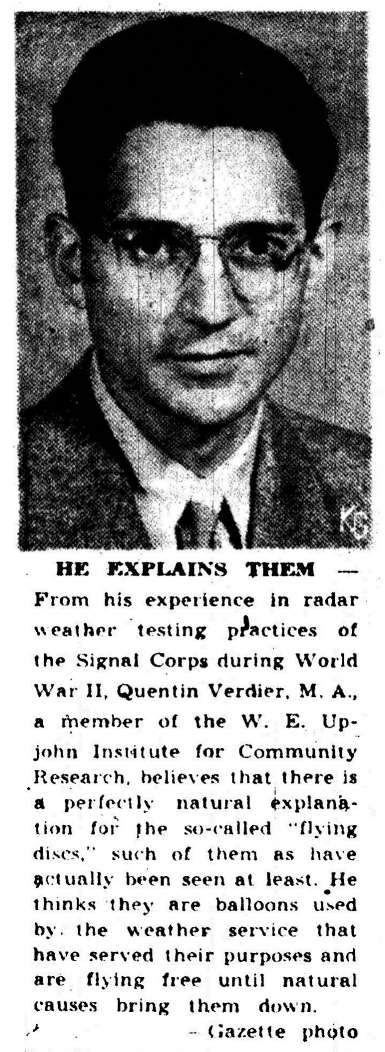Kalamazoo (MI) Gazette, July 9, 1947, p. 9
(From Western Michigan University, Kalamazoo)
Radar Weather Expert Claims Disc Solution
-------------
Only Hydrogen-Filled Balloons, He Says
--------------
Radar weather testing methods, as developed and used by the army air forces during the war, may hold the secret behind the mass reports of “flying saucers,” according to the theory of a Kalamazoo war veteran familiar with the radar techniques.
That the flying discs, reported at great heights, may be only hydrogen-filled balloons, carrying weather equipment aloft, was expressed by Quentin Verdier, of 621 Academy street.
With Upjohn Institute
Verdier spent nearly three years with the air forces weather service, and studied and became familiar with the spherical balloons used to hoist instruments and gadgets for plotting the weather. He is a graduate of Kalamazoo College, and since returning from service, has received his master of arts degree. He is now employed on the staff of the W. E. Kellogg Institute for Community Research.
During the war, citizens along the New Jersey coast often expressed alarm at finding the remnants of such weather “kites,” Verdier said. Even though markings on all such equipment identified it as the property of the signal corps, the citizens were usually certain that German or Japanese submarines had a secret weapon up their sleeves.
Sort of Punctures Myth
Verdier was stationed for a time at Spring Lake, N.J. where the radar weather testing methods were developed. He offers what he believes to be several logical explanations for the reports of discs streaking across the skies, without leaving any trace of their origin or destination.
First, he points out, the objects are described as disc or saucer shaped. The weather balloons are of synthetic rubber, easily blown into odd shapes by the high winds. They are nearly white, Verdier points out.
The reports of them being in various colors could be explained by the fact the white balloons carry silver-colored radar targets, and because red pilot balloons are also used.
Travel at Great Speed
The radar balloons travel at great speeds about 40,000 feet. The speed of the wind at that height is often as high as 200 miles an hour, Verdier says.
The fact no evidence has been found to identify the discs causes him to believe more firmly that they are nothing more than the hydrogen-filled balloons which burst and fall and appear on the ground as an old piece of paper or rag.
The discs make no sound, he states, because the balloons travel with the wind and make no noise.
Reports of seeing the discs in flying formations are to Verdier mere optical illusions or pure exaggeration on the part of the observers.
Two Methods Explained
He says two methods are used for plotting the weather by radar. The first employs a tinfoil radar target attached to the bottom of the balloon. (He said one was pictured in Monday’s Gazette as having been found in Ohio.) The balloons which carry these tinfoil targets are five to six feet in diameter and expand at high altitudes. Using the radar beam to keep contact with the tinfoil target, observers on the ground can figure the wind velocity at different levels.
The second method calls for the use of an instrument called the “RDF, or Radio Direction Finder.” In this process, small transmitters are hoisted to high altitudes by suspension from balloons. The transmitters are adjusted so as to send code messages to the ground giving the temperature, pressure and humidity at various levels.
Well-filled hydrogen balloons can rise to 60,000 feet before bursting, Verdier states, while partially filled ones will ascend higher.
Airplanes are unable to locate the weather “kites,” he says. It was tried during the war. He thinks that is why planes searching for the discs on the West coast have been unable to find any.
Photo Caption
HE EXPLAINS THEM---
From his experience in radar weather testing practices of the Signal Corps during World War II, Quentin Verdier, M. A., a member of the W. E. Upjohn Institute for Community Research, believes that there is a perfectly natural explanation for the so-called “flying discs, such of them as have actually been seen at least. He thinks they are balloons used by the weather service that have served their purposes and are flying free until natural causes bring them down.
--Gazette photo.



 [Time Stamp] 1947 Jul 9 03 21 Z [10:21 P.M. EST, July 8]
[Time Stamp] 1947 Jul 9 03 21 Z [10:21 P.M. EST, July 8]
WAR V WU A50 NL PD
WAR DEPT
INTELLIGENCE DIV WASHDC
SUGGEST SAUCERS ARE RADAR TARGET FOR WEATHER OBSERVATION
PURPOSES CONTACT COL M DUFFY SPRING LAKE NEW JERSEY FOR
INFORMATION
TONY GASTON NEWS EDITOR WKZO
WKZO.
Handwritten notes:
CA from ID (Col Boyd) to AAF (Maj Mickly) 7-9-47 Celr RLT
C/A received from ACB and sent to Suin Jif (?) 7/10/47
